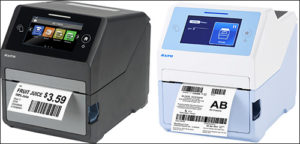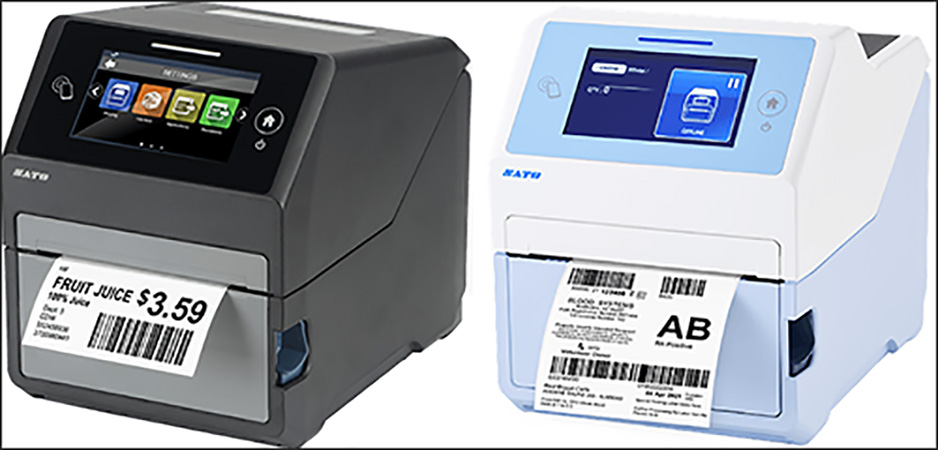Presented here are recent news announcements regarding the following organizations: HID Global, Checkpoint Systems, STMicroelectronics, the Mioty Alliance, SATO America, Luner, Sierra Wireless, Link Labs, STAR Systems International and Argonne National Laboratory.
HID Adds Multi-Factor Authentication to Trusted-Identity Platform
HID Global, a provider of trusted-identity solutions, has announced the availability of its WorkforceID Authentication solution, the latest addition to its cloud platform for issuing, managing and using identity credentials in physical and digital workplaces. Workforce ID Authentication is part of HID’s multi-factor authentication platform for consumer applications, including online and mobile banking, as well as its suite of workforce-identity solutions, such as employee ID badges and visitor-management systems.
 “A person’s identity has become the new security perimeter in a hybrid workplace that now extends from home to the office and everywhere in between,” said Julian Lovelock, HID’s VP of global business, in a prepared statement. “The addition of multi-factor authentication to the HID WorkforceID platform advances our vision of a unified and flexible approach to identity and access management for an organization’s employees, partners and contractors. This is the next step in providing a suite of applications that manage digital and physical identity credentials through one convenient cloud platform.”
“A person’s identity has become the new security perimeter in a hybrid workplace that now extends from home to the office and everywhere in between,” said Julian Lovelock, HID’s VP of global business, in a prepared statement. “The addition of multi-factor authentication to the HID WorkforceID platform advances our vision of a unified and flexible approach to identity and access management for an organization’s employees, partners and contractors. This is the next step in providing a suite of applications that manage digital and physical identity credentials through one convenient cloud platform.”
As part of HID’s overall multi-factor authentication portfolio, the HID WorkforceID Authentication solution enables organizations to extend a secure login experience to users in a diverse and dynamic enterprise environment. It integrates with Microsoft’s on-premise Active Directory (AD) or cloud-based Azure AD. The solution extends HID’s authentication ecosystem, which includes its comprehensive credential offering and WorkforceID Digital Credential Manager for managing workforce authenticators used for both physical and digital access.
The platform is positioned to enable simplified deployment and administration (easy integration with cloud-based, on-premise, or hybrid legacy applications, as well as existing enterprise technology, including Virtual Private Networks for remote login), multiple authentication factors (HID ActivID one-time password tokens and security keys, smart cards, and the HID Approve mobile app that enables users to authenticate to applications and deny fraudulent login attempts via their phone), standards-based security (ISO 27001 standards, SOC2-certified and EU GDPR-compliant), and an intuitive user experience featuring self-service tasks for setting up authentication methods.
Checkpoint Expands IoT RFID Software for Omnichannel Retail
Checkpoint Systems, a vertically integrated solutions provider for retail, has announced the expansion of its HALO Internet of Things (IoT) RFID software platform with the release of HALO 12.2.0. This latest release includes a number of new features. It provides improved replenishment capabilities and expanded language options for increased usability and quicker international rollout capabilities, the company reports, as well as extended enterprise reporting and enhanced omnichannel in-store fulfilment capabilities. This enables retailers to support omnichannel retailing.
HALO 12.2.0 includes a replenishment feature that aggregates and lists products to be picked, grouping single items together and speeding up ecommerce processes. Employees can pick items or model SKUs depending on their product master, making the process of locating stock and delivering it to the shop floor easier and more efficient, the company reports. This is intended to reduce time and improve in-store operations, as well as decrease customer wait times and improve the in-store experience. The HALO platform facilitates efficiency, Checkpoint explains, and drives revenue-generating actions. By delivering near-real-time targeted and actionable insights, the system enables retailers to set tasks to be automatically carried out.
 According to the company, the system’s enhanced replenishment capabilities make picking and sales floor stocking easier, faster and more efficient. Expanded in-store receiving capabilities provide stores with insights into stock arrivals, ensuring stock is moved to the sales floor faster. Omnichannel in-store fulfilment with expanded shipping and packing capabilities enables retailers to make efficient use of brick-and-mortar stores to handle omnichannel purchases.
According to the company, the system’s enhanced replenishment capabilities make picking and sales floor stocking easier, faster and more efficient. Expanded in-store receiving capabilities provide stores with insights into stock arrivals, ensuring stock is moved to the sales floor faster. Omnichannel in-store fulfilment with expanded shipping and packing capabilities enables retailers to make efficient use of brick-and-mortar stores to handle omnichannel purchases.
Expanded reporting capabilities provide a performance overview of a business with metrics on KPIs designed to facilitate enterprise-wide success. Increased RFID device options make the software platform compatible with a wider range of devices already deployed by stores. Inventory count options, enabled via a standard API, simplify connections to different fixed sensors, robots and drones, in order to make the stock-counting process more accurate and efficient. Expanded translation capabilities allow quick and efficient customization to local dialects so that HALO can be deployed faster across an international estate.
“With a regular cadence, Checkpoint provides ever-expanding capabilities of the HALO RFID software platform,” said Phil Fisher, Checkpoint Systems’ HALO software product director, in a prepared statement. “We have a technical team dedicated to constantly developing and improving the features so we can plan and release updates, delivering changes that have a positive impact on retailer operations. As a result, HALO will continue to evolve and help retailers improve their financial performance, support omnichannel and enhance consumer experiences.”
STMicroelectronics Joins Mioty Alliance to Foster IoT Applications
STMicroelectronics, a semiconductor company serving electronics customers, says it hopes to inspire massive IoT applications, driven by scale rather than speed, through its support for the Mioty standard, which enables scalable, long-range and low-power wireless connections. In joining the Mioty Alliance, which maintains the specifications and promotes the technology, ST has announced the availability of a protocol stack from authorized partner Stackforce, which allows customers to create Mioty devices using the STM32WL wireless system-on-chip.
 “Mioty promises to make exciting new massive IoT applications possible, for instance, to cover a large geographical area,” said Hakim Jaafar, STMicroelectronics’ STM32 wireless marketing director, in a prepared statement. “The Mioty stack further strengthens the ecosystem around our STM32WL SoC, which supports various common sub-GHz LPWAN technologies such as LoRaWAN, Sigfox, and wM-Bus, and delivers a unique level of integration that saves space, power, and time to market.”
“Mioty promises to make exciting new massive IoT applications possible, for instance, to cover a large geographical area,” said Hakim Jaafar, STMicroelectronics’ STM32 wireless marketing director, in a prepared statement. “The Mioty stack further strengthens the ecosystem around our STM32WL SoC, which supports various common sub-GHz LPWAN technologies such as LoRaWAN, Sigfox, and wM-Bus, and delivers a unique level of integration that saves space, power, and time to market.”
Mioty sends messages using a telegram-splitting technique, which is recognized and standardized by the European Telecommunication Standards Institute. This ensures extremely short radio transmissions that allow extended operation without the logistical challenges of replacing batteries in massive IoT networks. Short transmissions minimize interference with nearby signals and allow thousands of Mioty nodes to coexist on the same network.
Mioty data packets can travel several kilometers in built-up areas and more than 15 kilometers with line of sight, allowing a few base stations to cover large industrial sites or outdoor areas, such as oilfields. In addition, Mioty devices can communicate while moving at up to 120 kilometers per hour without signal-fading issues, serving applications such as fleet management, asset tracking, and theft detection. The Mioty protocol stack for the STM32WL has been developed by Stackforce. The stack is available as a library for direct application integration or firmware, ready to be flashed directly onto the SoC for modem-like use.
SATO America Adds RFID to Thermal Printers
SATO America has announced that its CT4-LX thermal desktop printer is now available with HF RFID (optional factory-installed) in both 203 and 305 dpi versions. The HF RFID printer models are in addition to its UHF RFID printer models released last year, the company reports, providing greater flexibility for RFID tags, inlays and applications.
Standard features include a 4.3-inch full-color touch screen display, multiple connectivity options, and existing application support using onboard competitive emulations, along with instructional videos.
SATO has also announced its CT4-LX-HC healthcare thermal desktop printer, which is now available in 203 and 305 dpi thermal transfer models. The additional 203 dpi print resolution models extend the printer’s functionality into a variety of other healthcare segments and environments where an anti-microbial and wipe-down-ready printer surface is required.
Standard features include clinical-ready antimicrobial plastic casing, disinfectant wipe-down capability, a full-color touch display and multiple connectivity options, as well as existing application support and on-board videos. SATO has also added an optional guillotine cutter for this model.
Luner Launches IoT Developer Marketplace, Partners with Sierra Wireless
Luner, a technology-agnostic self-service IoT connectivity platform for IoT developers and SMEs, has launched its IoT Marketplace, providing a one-stop-shop for developers looking to get their IoT projects off the ground. The Luner Marketplace will provide a growing selection of IoT hardware and related products for the development of end-to-end IoT solutions. The first hardware partner to offer its devices via the Marketplace is Sierra Wireless, a provider of IoT solutions.
Luner is offering its AirLink cellular routers and gateways, which are designed for IoT and enterprise applications. These include the AirLink RV55, a rugged, compact, LTE-A Pro router designed to connect critical remote assets, infrastructure and vehicles; the AirLink RV50X, an LTE-advanced gateway; and the AirLink LX40 and LX60 LTE-M (global) and Cat 4 (EMEA) range, designed for commercial and enterprise LTE applications, such as IP cameras, security, point-of-sale terminals and smart lockers.
The Luner Marketplace can be used to source IoT devices and components, or as a complement to Luner’s global IoT SIM cards. The self-service connectivity platform has been designed for easy self-onboarding and self-management of SIM cards via a single intuitive interface, according to the company. Luner’s IoT data plans are available on a pay-as-you-go basis, with no contracts or monthly bills.
For larger-scale projects, the company’s Luner Enterprise Plan offers flexible data pools with the ability to upgrade or downscale data use each month. The platform offers granular management of IoT connectivity, including control of data limits and unlimited access to data usage records. Users can access an API suite to integrate the service directly into their application layer or software.
“We are excited to launch the Luner Marketplace and to welcome Sierra Wireless as our first hardware partner,” said Nicola Pickard, Luner’s business-development director, in a prepared statement. “This is an important step in our mission to become the first truly agnostic IoT marketplace, giving IoT applications developers fast and easy access to all the elements they need to build and power their IoT applications. We will continue to add a wide selection of partner products to the Luner Marketplace over the coming months, and we encourage other hardware partners to join us as we provide developers with a one-stop-shop for all the components of their IoT applications.”
“Our secure and intelligent range of AirLink cellular routers and gateways allow both big and small businesses to easily set up wireless communications systems for applications such as fleet management, business continuity, security and remote monitoring,” added Marc Overton, Sierra Wireless’ CSO and senior VP of EMEA and APAC, in the prepared statement. “Sierra Wireless is focused on enabling businesses to transform and thrive in today’s connected economy and we are pleased to now be able to offer our AirLink cellular routers and gateways to Luner’s IoT Marketplace customers.”
Link Labs Receives Six IoT Asset-Tracking Software Patents
Link Labs, a provider of an enterprise IoT platform for locating, managing and monitoring equipment, supplies and assets, has announced the awarding of six U.S. patents for technological innovations in its AirFinder OnSite IoT asset-tracking platform.
“Our AirFinder OnSite innovations at the firmware level of IoT devices resolve an array of technical challenges that are critical to making enterprise-grade IoT asset tracking more precise, more power-efficient and more affordable,” said Bob Proctor, Link Labs’ CEO, in a prepared statement. “The challenges addressed by our software engineering—including ranging methodology, interference avoidance, location algorithm, power efficiency and scalability to high tag densities—power AirFinder OnSite’s first-ever fine-tuning of asset location to the sub-meter level.”
“Our six innovations also unlock the keys to dramatic improvements in battery life at the tag level, unprecedented speed in determining tag location and unmatched reductions in infrastructure cost and total cost of ownership,” Proctor added. “All of our innovations are supported by industry-standard Bluetooth Low Energy (BLE) chipsets, which allows these new advanced capabilities to be incorporated into any manufacturer’s BLE tags with a simple firmware upgrade.”
Launched in March 2021, AirFinder OnSite is an enterprise IoT platform for managing hundreds to millions of items. The platform features customized reporting and analytics and can be integrated into business workflows. It is suitable for IoT asset tracking at facilities with large footprints, the company reports, such as distribution centers, warehouses, manufacturing sites and hospitals. AirFinder OnSite is initially being offered to early technology adopters through Link Labs’ AirFinder Early Access Program, with general availability expected sn Summer 2021. The patents include:
- U.S. Patent No. 10,985,787: System and Method for Generating Phase-Coherent Signaling When Ranging Between Wireless Communication Nodes: A wireless communication technique that greatly reduces the time required to determine a tag’s location, to under 10 milliseconds. It also more than doubles the power efficiency of a phase-ranging asset-tracking system by substantially reducing the amount of data that needs to be exchanged between a tag and a location beacon.
- U.S. Patent No. 10,708,970: BLE Networking Systems and Methods Providing Central and Peripheral Role Reversal with Enhanced Peripheral Location Determination Using Constant Tone Extension Analysis for a Same Channel: A communication system that pinpoints a tag’s location by performing calculations on the tag using phase ranging to three or more location beacons (i.e., multilateration). This technique significantly improves the efficiency of the tag’s data backhaul, the part of a network that comprises the intermediate links between the core network and the small subnetworks at the edge of a network, and its power consumption.
- U.S. Patent No. 10,845,451: Apparatus and Method for Mitigating Interference When Phase Ranging Among Beacons and Tags: A technique that mitigates interference from unrelated devices on individual communication channels used by tags and beacons within an enterprise asset tracking network. When there are many Bluetooth, WiFi and short-range radio devices in local proximity competing for the same wireless channel bandwidth within an enterprise network—such as in offices, hospitals or industrial environments—this technique efficiently maintains both location accuracy and power efficiency.
- U.S. Patent No. 10,862,520: Apparatus and Method for Mitigating Effects of Multipath Interference Between Wireless Communication Nodes via Constraint of Estimated Node Location: A method for increasing accuracy in location measurement that uses a wireless communication node to reduce and resolve multipath interference. Because most indoor asset tracking environments have moderate to high levels of interference, this technique mitigates the impact of multipath and non-line of sight signal paths between a tagged asset and the location of a reference beacon. Even when the direct path of a signal is blocked by walls or the signal bounces off metal objects or large pieces of industrial equipment, this technique maintains location accuracy.
- U.S. Patent No. 10,887,860: Apparatus and Method for Optimizing Wireless End Node Location Determination Via Targeted Proximity Ranging to Clusters of Other Wireless Nodes: A communication technique for adding more beacons to an asset tracking system without degrading accuracy by detecting and clustering four or more groups of beacons based on their location. For IoT applications with a large number of tags in one location, such as a warehouse, this technique is a low-cost way for expanding a system’s capacity and managing data from a large number of tagged assets.
- U.S. Patent No. 10,873,949: Battery Watchdog System and Methodology: A battery system that incorporates a watchdog and power throttling capability to monitor a device’s battery consumption and control various functions and timing of events, which conserves power and ensures a device meets its required minimum life of operation.
STAR Systems Unveils Smart Windshield and Headlamp Transponder
STAR Systems International, a provider of smart-city solutions, has announced its Zenith windshield and headlamp transponder. Zenith provides memory protection, data security and read sensitivity, the company reports, and it protects stored memory with an error-correcting architecture that is immune to single-bit errors, such as bit flips. In addition to permanently locked and 96-bit TID and password-read protected user memory, Zenith provides a dynamic verification process that prevents cloning attempts.
The transponder offers read sensitivity of -22.5 dBm and features an antenna that will work on either a windshield or a headlamp, making it suitable for any vehicle, according to the company. “The Zenith is designed to meet and exceed interoperability standards in Tolling,” said Chris Cheung, STAR Systems’ senior manager of technical marketing, in a prepared statement. “The new product is currently undergoing OmniAir certification and is expected to be completed soon.”
Zenith comes with STAR Systems’ “non-removable, non-transferable” (NRNT) tamper-evident feature or “tamper evident break on removal” (BOR) features. The material construction allows for long-term reliability and durability in the types of harsh environments typically found in automatic vehicle identification (AVI) applications, the company reports.
“This industry is in need of a next generation transponder,” added Robert Karr, STAR Systems’ CEO, in the prepared statement. “Zenith delivers an unparalleled combination of performance, advanced features, quality and reliability. We expect it to be a very successful product.” Zenith is intended for such applications as electronic toll collection, congestion pricing, electronic road pricing, electronic vehicle registration, parking and access control, and more, and the product is currently available for shipment.
Argonne National Laboratory to Host Printed Electronics Webinar
Scientists at the U.S. Department of Energy’s Argonne National Laboratory will host a webinar on May 19 to explore the challenges and opportunities for materials in printable hybrid electronics. Advancements in material and device fabrication technologies have enabled the proliferation of low-cost, low-power, printed hybrid electronic devices for a variety of applications, including chemical sensors, radio frequency antennas, lab-on-chip healthcare devices, organic neuromorphic devices and more. The next generation of printed hybrid electronics will require materials with high performance, durability and recyclability, creating a continuing need for materials innovation.
During the webinar, experts from industry, government and academia will discuss the state-of-the-art in materials for printed hybrid electronic devices for communications, sensing and computing, as well as the materials now being discovered, developed and commercialized. The event will feature a live tour of the equipment, technologies and resources available to partners and users at the Argonne National Laboratory, including its newly expanded Materials Engineering Research Facility, the Center for Nanoscale Materials and the Advanced Photon Source.
Yuepeng Zhang, a principal materials scientist at Argonne, will kick off conversations with several questions: What are the trends that influence the direction of materials innovation? What are the major technology gaps that must be closed to enable the next generation of materials to be commercialized? What are the most promising scientific advances in this area? And how can public-private partnerships support U.S. competitiveness?
Other speakers will include Matthew Dyson, IDTechEx; Eric Forsythe, the NextFlex Manufacturing Institute; Stijn Gillissen, Henkel; Mark Hersam, Northwestern University; Melbs LeMieux, Electroninks; Matthew Tirrell, the University of Chicago and Argonne National Laboratory; Sihong Wang, the University of Chicago; and Angel Yanguas-Gil, Argonne National Laboratory. You can learn more and register for the webinar here.


